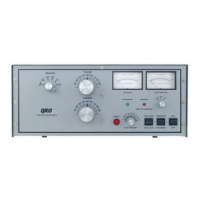19
Two minute warmup cycle not functioning Components on LV & Bias PCB
1. U3 555 Timer and related components
2. Transistor Q1
3. K3 Relay
CIRCUIT DESCRIPTIONS
Refer to the Appropriate Schematic Diagrams and PCB Layouts while you read the following
paragraphs.
POWER SUPPLY
Power transformer T1 supplies the power required to operate the Linear Amplifier. A dual-winding
primary allows the amplifier to be operated from 200 VAC or 240 VAC. Two 20 ampere fuses
protect the transformer against overload. Capacitors C10 & C11 provide AC line bypassing. This
amplifier uses a special combination safety interlock/solid state relay circuit. Interlock switch
SW1, On/OFF power switch SW2A&B must be closed before power is supplied to the primary of
transformer T1. Solid State Relays SR1 & SR2 provides a soft start when the amplifier is switched
on. They only turn on when the AC line voltage crosses the zero degree point of the sine wave
Terminal Block TB1 allows for the selection of the line voltage to be used. See the Terminal Block
Wiring Diagram for the correct wiring. Cooling Fan B1 is provided 100/120 VAC by connection
across only one of the primary windings at TB1. B1 always operates on 100/120 VAC regardless
of which AC line voltage is used. Switch SW4 in combination with resistors R307A & R307B
provide a high or low setting for the fan. The secondary windings of T1 provides the following
secondary voltages: 1,900 VAC Plate Voltage Supply & 200 VAC Screen Voltage Supply.
PLATE VOLTAGE
The 1900 VAC output of T1 is connected to a full-wave bridge rectifier circuit consisting of the
components on HV Capacitor PCB and HV Diode PCB. Diodes D101 - D120 rectify the
secondary AC voltage and capacitors C200 - C207 filter this voltage. Capacitors C101 - C120 are
connected across the diodes to protect them against transients. Resistors R200 - R207 are
connected across the filter capacitors to equalize the voltage drop across each capacitor. These
resistors also act as bleeder resistors for the filter capacitors to discharge them when the amplifier
is turned off. One of the red 1900 VAC secondary leads is connected to the junction of D101
&D106, and the other red 1900 VAC secondary lead is connected to the junction of D111 & D116.
During the AC line cycle when the lead at D101 & D106 junction is positive, diodes D101 - D105
& D111 - D115 conduct and capacitors C200 - C207 are charged. During the other half of the AC
line cycle, the red lead connected to the junction of D111 & D116 becomes positive. Capacitors
C200 - C207 charge and Diodes D106 - D110 & DD116 - D120 conduct. The capacitor bank
charges to the peak voltage of the 1900 RMS VAC secondary voltage (1900 VAC x 1.414
=2,686.60 VDC).

